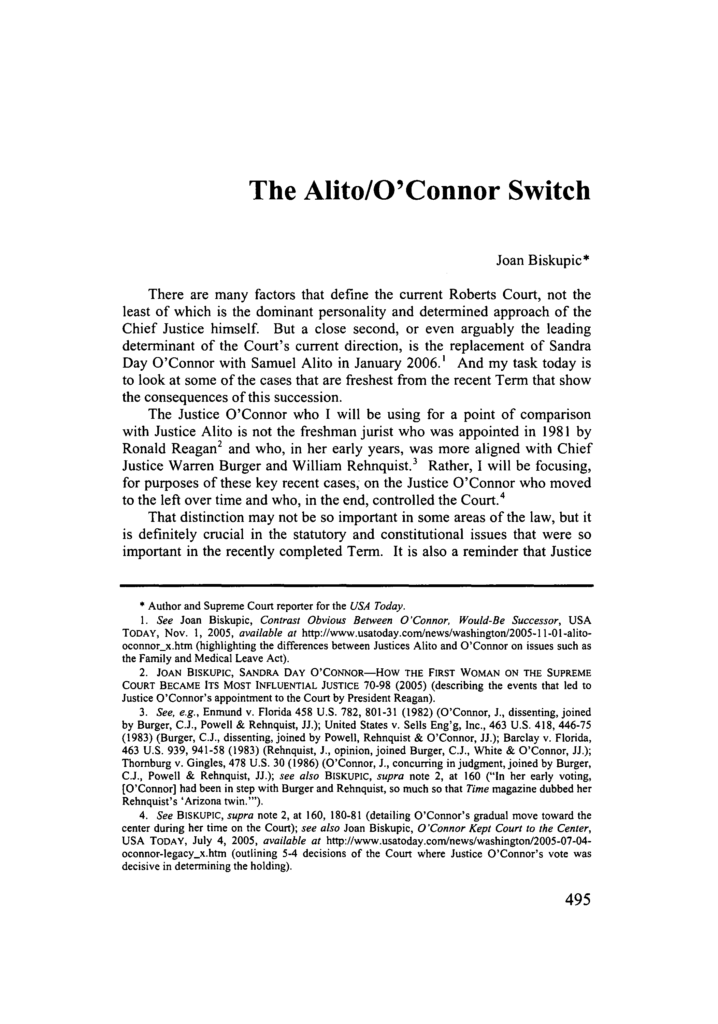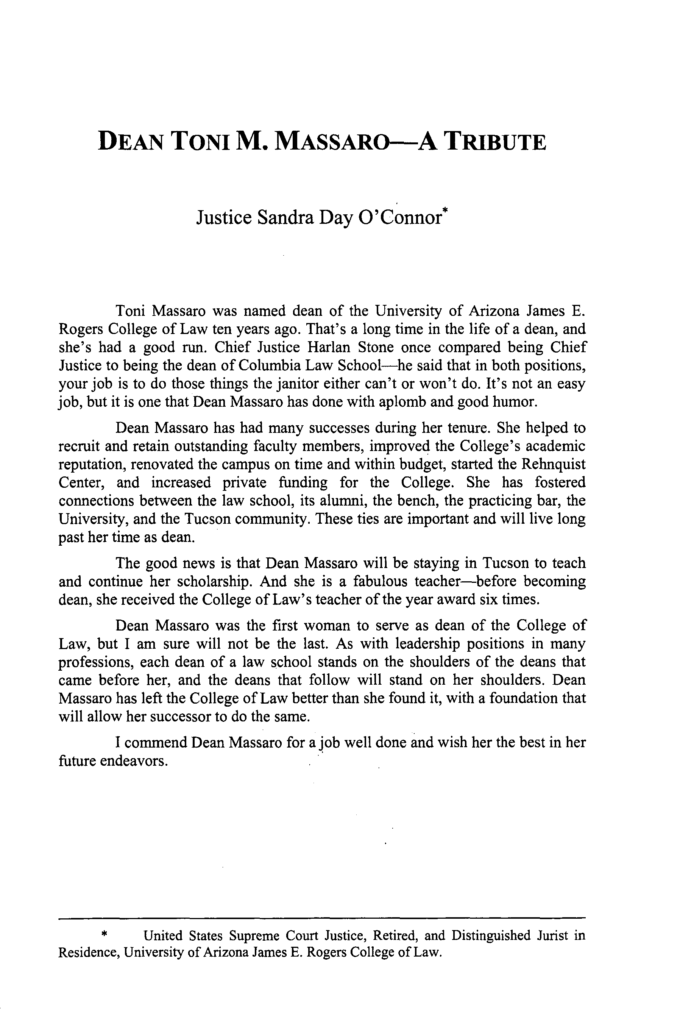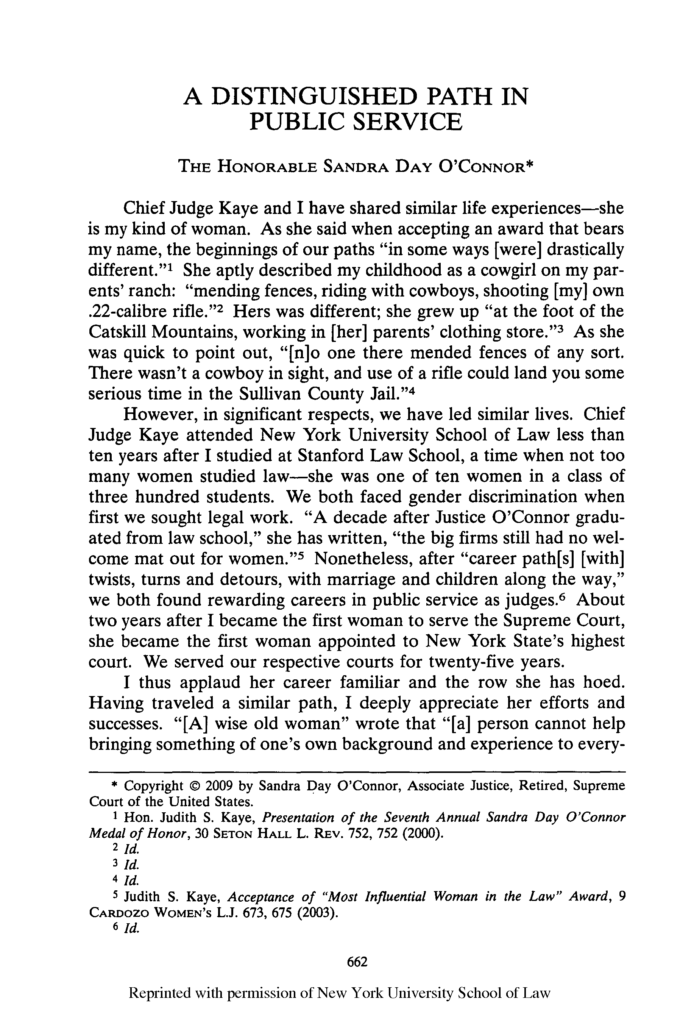Introduction: Justice Sandra Day O’Connor (Ret.) Symposium
INTRODUCTION: Justice Sandra Day O’Connor (Ret.) Symposium
Scott Bales*
This symposium edition of the Arizona State Law Journal reflects that February 2010 was the occasion for an Arizona reunion of the nearly one hundred former law clerks of U.S. Supreme Court Justice Sandra Day O’Connor (Ret.). The reunion allowed the former clerks to hold an early birthday celebration for the Justice, who turned 80 in March 2010, and who herself had been an enthusiastic organizer of in-chambers birthday celebrations for her law clerks and staff.
In planning the reunion, the former clerks quickly concluded that it would be desirable to involve the Sandra Day O’Connor College of Law at Arizona State University. The law school had been named after Justice O’Connor in 2006 in honor of her lifelong dedication to public service, her intellectual vigor, and her fair-mindedness. A law clerk reunion offered an ideal opportunity for former clerks to visit the law school bearing her name. Dean Paul Berman promptly embraced this idea, suggesting that the law school could help host a symposium and related events. When this idea was raised with Justice O’Connor, she responded that a symposium would be just fine, but it would be much better if instead of looking back at her work on the Court, it highlighted the on-going scholarship of some of her former law clerks who are now law professors. The symposium also provided an opportunity to discuss the Justice’s efforts to promote civic education, a project
Justice Sandra Day O’Connor: A Selected Annotated Bibliography
JUSTICE SANDRA DAY O’CONNOR: A SELECTED ANNOTATED BIBLIOGRAPHY
Julie Graves Krishnaswam/
WORKS AUTHORED BY JUSTICE O’CONNOR 1102
The Judiciary, Judicial Philosophy, Federalism and
International Law 1102
Equality and Feminism 1112
The Legal Profession and Professionalism 11 l 5
Tributes 1118
Autobiographical Works 1121
WORKS ABOUT JUSTICE O’CONNOR 112 l
Substantive Law Review Articles Written About
Justice O’Connor 112 l
Scholarly Monographs and Book Chapters About
Justice O’Connor 1143
Biographical Works 1146
Tributes to Justice O ‘Connor 1147
By Supreme Court Justices 1147
By Members of the Legal Profession 1149
As the first woman appointed to the Supreme Court, Justice Sandra Day O’Connor is a profound and fascinating figure in American jurisprudence. During Ronald Reagan’s presidential campaign, he promised to appoint a woman to the Supreme Court, and he appointed Sandra Day O’ Connor. 1 She was confirmed in 1981 and spent the next twenty-four years on the Supreme Court bench, retiring in 2005. Before her time on the Court, Justice O’Connor
+ Reference/Faculty Research Librarian and Associate Law Library Professor, City University of New York (CUNY) School of Law. B.A., 1999 Reed College, J.D., 2004, CUNY School ofLaw, M.L.I.S., 2008, Pratt Institute. The author wishes to thank Julie Lim, Director, CUNY School of Law Library, and colleagues Raquel Gabriel and Sarah Valentine for encouragement and assistance. The author also acknowledges the support of a research
The Alito/O’Connor Switch
The Alito/O’Connor Switch
Joan Biskupic*
There are many factors that define the current Roberts Court, not the least of which is the dominant personality and determined approach of the Chief Justice himself. But a close second, or even arguably the leading determinant of the Court’s current direction, is the replacement of Sandra Day O’Connor with Samuel Alita in January 2006.1 And my task today is to look at some of the cases that are freshest from the recent Term that show the consequences of this succession.
The Justice O’Connor who I will be using for a point of comparison with Justice Alita is not the freshman jurist who was appointed in 198 l by Ronald Reagan2 and who, in her early years, was more aligned with Chief Justice Warren Burger and William Rehnquis t.3 Rather, I will be focusing, for purposes of these key recent cases; on the Justice O’Connor who moved to the left over time and who, in the end, controlled the Court.4
That distinction may not be so important in some areas of the law, but it is definitely crucial in the statutory and constitutional issues that were so important in the recently completed Term. It is also a reminder that Justice
Author and Supreme Court reporter for the USA Today.
See Joan Biskupic, Contrast Obvious Between O’Connor, Would-Be Successor, USA TODAY, Nov. I, 2005, available at http://www.usatoday.com/news/washington/2005-11-0l-alito oconnor_x.htm (highlighting the differences between Justices Alito and O’Connor on issues such as
Our Judicial Federalism
Case Western Reserve Law Review
Volume 35 1984-85 Number 1
OUR JUDICIAL FEDERALISM*
Justice Sandra Day O’Connor**
IN PREPARING for today’s talk I knew you might like to hear how I set about deciding cases, just what really goes on inside the Court, and how I feel personally about my colleagues on the bench, and so on. But one of the qualities desirable for a Justice is to be judicious and, therefore, those subjects are best avoided. It is not even advisable to speak about most of the interesting issues of the day, since, as Alexis de Tocqueville noted, almost every issue in American life is likely, sooner or later, to end up before the courts.1 When a Justice expresses an opinion on war or peace, on religion or politics, or even on science or literature, she always risks having her words embarrassingly quoted back at her in a brief or oral argu ment. As a result, we usually follow the advice of Calvin Coolidge:
“If you don’t say anything, you won’t be called on to repeat it.” 2
It is clear, however, that it is appropriate for me to say some thing today, and that what I say should somehow be suitable for the Canary Lecture. The Sumner Canary Lectureship honors a man who served as a leader of the Bar, as a United States Attorney, and a judge of the Ohio Court of Appeals.3 The Canary Lecture series is affiliated with the Case Western Reserve Law School, an institu tion which, as you know, originated as a department of Western Reserve and ultimately flourished as an integral
Dean Toni M. Massaro – A Tribute
Toni Massaro was named dean of the University of Arizona James E. Rogers College of Law ten years ago. That’s a long time in the life of a dean, and she’s had a good run. Chief Justice Harlan Stone once compared being Chief Justice to being the dean of Columbia Law School-he said that in both positions, your job is to do those things the janitor either can’t or won’t do. It’s not an easy job, but it is one that Dean Massaro has done with aplomb and good humor.
Dean Massaro has had many successes during her tenure. She helped to recruit and retain outstanding faculty members, improved the College’s academic reputation, renovated the campus on time and within budget, started the Rehnquist Center, and increased private funding for the College. She has fostered connections between the law school, its alumni, the bench, the practicing bar, the University, and the Tucson community. These ties are important and will live long past her time as dean.
The good news is that Dean Massaro will be staying in Tucson to teach and continue her scholarship. And she is a fabulous teacher-before becoming dean, she received the College of Law’s teacher of the year award six times.
Dean Massaro was the first woman to serve as dean of the College of Law, but I am sure will not be the last. As with leadership positions in many professions, each dean of a law school stands on the shoulders of the deans that came before her, and the deans that follow will stand on her shoulders. Dean Massaro has left
Interview with Litigation Magazine
Thoughts on Safeguarding Judicial Independence: An Interview with Justice Sandra Day O’Connor by Elaine E. Bueklo and Jeffrey Cole By any measure, former Supreme Court Justice Sandra Day O’Connor is a remarkable woman. She grew up on a cattle ranch in Arizona and majored in economics at Stanford University, graduating in 1950 with high honors. Two years later, she graduated magna cum laude from Stanford Law School, where she served on the Stanford Law Review and was elected to membership in the Order of the Coif It was there that she met her husband, John, and began her lifelong friendship with William Rehnquist. She returned to Arizona and to the private practice of law until 1965. There then followed a four-year stint as assistant attorney general for Arizona. In 1969, she was appointed by the governor ofArizona to a vacancy in the state senate. Thereafter, she was elected to the Arizona Senate and served as the Republican majority leader—the first woman to serve as majority leader of a state senate in the United States. But her ultimate aspirations and acumen were judicial, not political, and she successfully ran to be a trial judge for the Superior Court of Maricopa County in 1975. Four years later, she was nominated by the newly elected Democratic governor of Arizona to the Arizona State Court of Appeals. President Ronald Reagan nominated her to be the first woman on the Supreme Court of the United States in July 1981. She was immediately and unanimously confirmed by the
“Thoughts on Safeguarding Judicial Independence: An Interview with Justice Sandra Day O’Connor”
By any measure, former Supreme Court Justice Sandra Day O’Connor is a remarkable woman. She grew up on a cattle ranch in Arizona and majored in economics at Stanford University, graduating in 1950 with high honors. Two years later, she graduated magna cum laude from Stanford Law School, where she served on the Stanford Law Review and was elected to membership in the Order of the Coif. It was there that she met her husband, John, and began her lifelong friendship with William Rehnquist. She returned to Arizona and to the private practice of law until 1965. There then followed a four-year stint as assistant attorney general for Arizona. In 1969, she was appointed by the governor of Arizona to a vacancy in the state senate. Thereafter, she was elected to the Arizona Senate and served as the Republican majority leader–the first woman to serve as majority leader of a state senate in the United States.
But her ultimate aspirations and acumen were judicial, not political, and she successfully ran to be a trial judge for the Superior Court of Maricopa County in 1975. Four years later, she was nominated by the newly elected Democratic governor of Arizona to the Arizona State Court of Appeals. President Ronald Reagan nominated her to be the first woman on the Supreme Court of the United States in July 1981. She was immediately and unanimously confirmed by the Senate. Justice O’Connor retired from the Court in January 2006 after 25 years of distinguished service during which she played
Interview in Principal Leadership magazine
Concerned about the declining emphasis on civics in schools, retired Supreme Court Justice Sandra Day C’Connor launched iCivics, a web-based education project for students and teachers. Editor’s note: For more information about iCivics, visit www.iCivicsorg. Sandra Day O’Connor, retired Supreme Court Justice, the first woman appointed to the court—and videogame designer? But yes. Justice O’Connor is the driving force behind iCivics, a nonprofit organization designed to increase students’ knowledge of civics through interactive i computer games that focus on history, laws, and government. “When I retired from the Supreme Court,” she explained, “I noticed ‘ that the attacks directed at our judicial system were broader and more vitriolic than any I had heard in my lifetime. It seemed to me that many of these attacks stemmed fi”om a basic misunderstanding of the role the judicial branch plays in our government. When I took a closer look at the problem, I saw that it wasn’t just the courts that our citizens misunderstood. Only one-third of Americans can name the three branches of government, much less say what they do. The decline of civic education has left our nation ignorant of the role of government as a whole. ” And she’s not the only one who is concerned about this gap in students’ education. Results from the most recent National Assessment of Educational Progress (NAEP) show that although the average score in civics for 4th graders has increased since 1998, scores at the 8th-grade
A Distinguished Path in Public Service (Tribute to Judge Judith Kaye)
Chief Judge Kaye and I have shared similar life experiences-she is my kind of woman. As she said when accepting an award that bears my name, the beginnings of our paths “in some ways [were] drastically different.”1 She aptly described my childhood as a cowgirl on my parents’ ranch: “mending fences, riding with cowboys, shooting [my] own .22-calibre rifle.” 2 Hers was different; she grew up “at the foot of the Catskill Mountains, working in [her] parents’ clothing store.”3 As she was quick to point out, “[n]o one there mended fences of any sort. There wasn’t a cowboy in sight, and use of a rifle could land you some serious time in the Sullivan County Jail.”4
However, in significant respects, we have led similar lives. Chief Judge Kaye attended New York University School of Law less than ten years after I studied at Stanford Law School, a time when not too many women studied law-she was one of ten women in a class of three hundred students. We both faced gender discrimination when first we sought legal work. “A decade after Justice O’Connor graduated from law school,” she has written, “the big firms still had no wel come mat out for women.” 5 Nonetheless, after “career path[s] [with] twists, turns and detours, with marriage and children along the way,” we both found rewarding careers in public service as judges. 6 About two years after I became the first woman to serve the Supreme Court, she became the first woman appointed to New York State’s highest court. We served our respective







